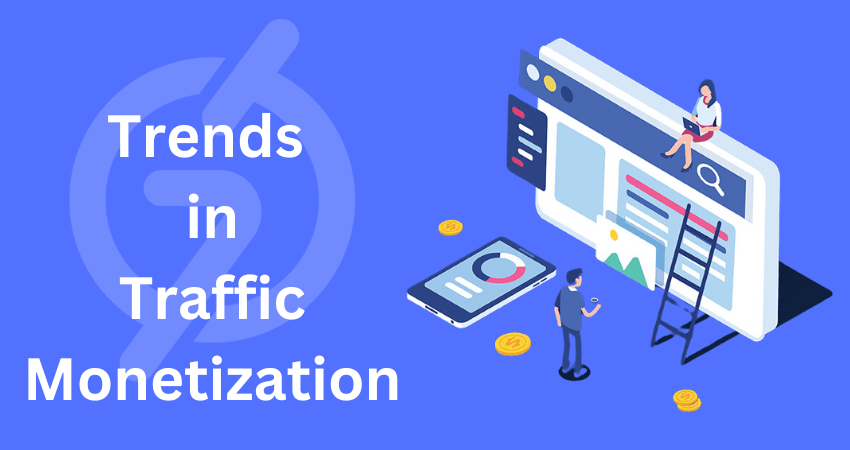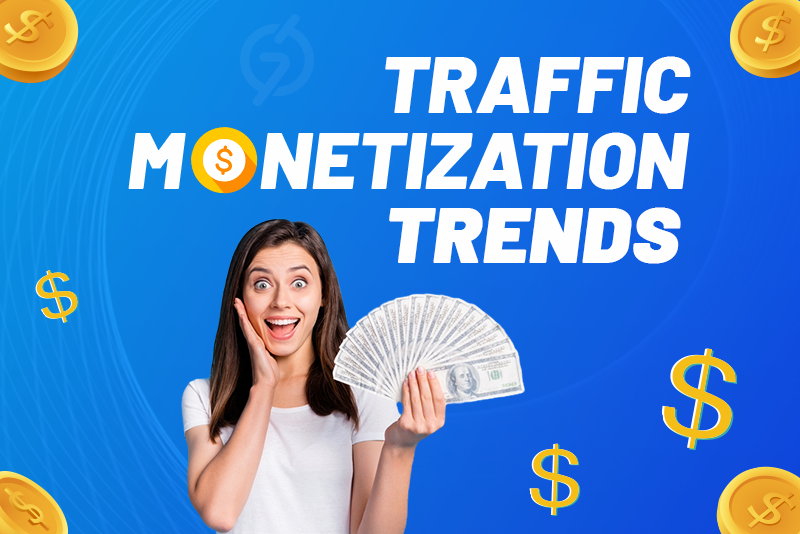Hard work pays off, but only for those who are willing to learn and adapt. Things can be simple only if you focus on what truly matters and prioritize effectively. Earning money through websites is not a big or new thing. Publishers have been doing it for a long time. Remember when having a website with lots of visitors translated into significant revenue? Those days are disappearing quickly. Now, traffic monetization is tougher than before.
Today, publishers are dealing with a tough situation: people who care about privacy, online ads that people are tired of, and algorithms that keep changing. These challenges break many publishers and force them to rethink their monetization strategies to stay relevant and sustainable in today’s digital landscape.
We believe a few breakers can not stop us from working on our monetization objectives. The important thing is to change the path, not the goal. Kick out all the old methods you are applying in your monetization strategy and add the new monetization trends that promise greater engagement and profitability in the ever-evolving world of web publishing.
In this blog, we will discuss top traffic monetization trends that will revolutionize how you earn from your website traffic.
The Concept of Traffic Monetization
Running a website successfully requires a lot of effort, time, and, yes, lots of investment. You can manage your time and also put in the effort, but how can you bring investment to the table? That’s why traffic monetization is essential for the smooth operation and smooth growth of your website.
It is the process of converting website or app visitors into revenue. Consider your website or app as a lemonade stand. Visitors are like thirsty passersby searching for something. Traffic monetization involves persuading them to purchase a refreshing glass of lemonade—whether through subscriptions, online ads, or premium features such as larger cups or cookies on the side (take it as an example).
There are various methods to achieve this. One common method is digital advertising, where relevant ads are displayed to your audience, generating income per click or impression. However, monetization goes beyond just ads. You can offer:
- Premium content for a fee,
- Sell products directly through your platform,
- Or even use your audience to attract affiliate partnerships.
The key is to comprehend your traffic (organic traffic and paid traffic) and customize your approach to convert those visitors into valuable assets for your website’s growth and sustainability.
Why is Traffic Monetization Beneficial for Publishers?
There are several advantages for publishers to monetize their traffic, both financial and strategic. Here are some of the key benefits:
- Increased Revenue Streams: Traffic monetization unlocks various ways to generate income from your quality traffic. This can include advertising, where you display targeted ads to your visitors. If you have a good amount of traffic on your website, the door of affiliate marketing is also open for you, where you can earn a significant amount as a commission by promoting other companies’ products or services.
- Content and Audience Growth: Traffic monetization has the potential to support the creation of more content. You can use the earnings to create better content, hire freelancers for content writing or making videos, and organize contests or giveaways to draw in more people. As your content improves, it will attract more traffic, resulting in increased revenue. This will enable you to continually enhance your website over time.
- Data Insights and Audience Understanding: Many traffic monetization platforms provide valuable analytics about your audience. The following data reveals the habits of your visitors:
- Demographics,
- Interests,
- Browsing habits.
These crucial data about your audience will help you customize your content strategy to their preferences. This will increase audience engagement and potentially higher ad revenue.
- Improved User Experience (UX): Not all ads are equally effective. Traffic monetization platforms offer a variety of advertising formats, such as:
- Banner ads
- Native Ads
- In-page push ads
Suppose you choose our advertising network, 7Search PPC, for monetization. We offer five ad formats so that you can easily select one that will not disturb your visitor’s experience.
Choosing the ad formats and strategically placing them on your website can create a seamless user experience that doesn’t disrupt content consumption. By doing this, you can achieve higher click-through rates and improve overall ad performance.
- Scalability and Growth Potential: An effective traffic monetization strategy enables your website to grow with your audience. As your traffic grows, so does your earning potential. This financial security gives you the freedom to experiment with:
- New Content Formats
- Marketing Strategies
- Website Features
All the above experiments aim to attract more visitors and establish your platform (app/website) as a leading authority in your niche.
Current Trends in Traffic Monetization
Monetization of traffic is a dynamic field that is constantly evolving with new approaches. The current trends in traffic monetization focus heavily on user-centric approaches and maximize revenue. Here are some key trends:

Integrating with an Ad Network
Utilizing the ad network’s power for monetization purposes is one of the most popular trends due to its scalability and access to a wide range of advertisers. This trend can help you by searching for the best and high-paying advertiser for your website that matches your niche and offers smooth payouts.
As a publisher, partnering with an ad network allows you to earn significant revenue each time the audience clicks on an ad displayed on your website or app. This passive income stream is facilitated by the ad network, which serves as an intermediary between you and advertisers.
Advertisers use ad networks to expand their reach to a broader audience. They pay for the exposure their online ads receive on publisher websites. Once your website meets the ad network’s standards and you have added their display ads, you can begin earning more effortlessly.
Joining ad networks can be a great way to monetize your website or app. Here is a breakdown of the process:
Choosing an Ad Network:
- Research: Don’t just choose any ad network! You must research advertising networks used by websites in your niche to find reputable options.
- Consider factors like:
- Advertisers Network Size: Bigger networks offer a wide range of advertisers.
- Ad Formats: Does the network offer formats that suit your website (e.g., banners, native ads)?
- Payment Method and Terms: How do they pay (e.g., PayPal, Bank Transfer), and what is the minimum payout threshold?
- Reviews: See what other publishers using the ad network have to say about their experience.
Applying and Getting Approved:
- Each network has its requirements: This can include minimum traffic volume, website traffic standards, and content guidelines. Make sure your website aligns with their criteria.
- Apply through the network’s website: The application process is usually straightforward.
- Approval Process: This can be instant or involve manual review by the ad network.
Placing Ads and Maintaining Compliance:
- Approval: Approved? Great! Now, you can choose ad formats and strategically place them on your website (e.g., in the sidebar, or within content). The 7Search PPC ad network allows you this level of control.
- Keep creating high-quality content: This is key to attracting and retaining visitors, which ultimately benefits your ad revenue.
- Stay compliant: Ad networks have policies about content and ad placement. Make sure you understand and follow them to avoid getting banned.
By following these steps and doing careful research, you can pick the best ad network for your needs and begin making money from your website successfully.
Pay-Per-Task Model: A Growing Trend in Traffic Monetization
The pay-per-task model is gaining traction as a way to monetize traffic. It offers an alternative to traditional subscription models, providing users with greater flexibility and potentially lower costs. Here is a breakdown of the model:
What is it?
In a pay-per-task model, users pay for individual tasks or projects they complete on a platform rather than subscribing for a set amount of features or actions. This allows for:
- Increased Flexibility: Users only pay for what they need, making it ideal for those with infrequent or specific needs.
- Potential Cost Savings: For users who don’t require constant service, this model can be more economical than a monthly subscription.
- Enhanced Credibility and Revenue: When you ask users a small fee for each task they desire, your website will be more credible and likely to earn more revenue.
Success Factors:
The viability of pay-per task model hinges on two key factors:
- Task Pricing: The per-task costs need to be balanced— affordable for users and profitable for the platform.
- Perceived Value: Users need to feel they are getting enough value from individual tasks to justify the cost.
Overall, the pay-per-task model offers a compelling alternative for both users and platforms.
Data Monetization
Data monetization is a growing trend in traffic monetization. It involves collecting and selling user data to third parties. It provides businesses with useful and valuable insights into user behavior and preferences. Here is a breakdown of this trend:
The Process:
Data Collection: This involves gathering user data through various methods, like:
- Website Cookies
- App Usage Data
- Surveys
Data Analysis: Extracting valuable insights from the collected data through techniques like segmentation and trend analysis.
Monetization Strategies: There are many ways to turn data into revenue:
- Selling Raw Data: Selling anonymized user data sets to businesses for research and analysis.
- Packaged Insights: Creating reports and market research based on user data and selling them to interested parties.
- Data-Driven Products: Integrating data and insights into existing offerings to improve user experience and personalization.
- Internal Use: Utilizing data to optimize internal operations, develop new products, and improve marketing strategies.
Blogging: A Big Impact Player in the Game of Traffic Monetization
Many of you may think, upon seeing the title, that blogging has been around for a long time, so how can we consider it a trend? My friend, we agree that blogging is an old player, but this strategy never goes out of the market.
While the blogosphere is vast, with over 600 million blogs in existence and predictions of a 40% increase by 2028, blogging remains a strong contender for traffic monetization. The key to success lies in prioritizing high-quality content. This means crafting valuable, interesting, and easy-to-read articles that resonate with your target audience. By building trust and attracting loyal readers, you will naturally increase your blog’s traffic and revenue.
These traffic monetization trends need patience. Building a profitable blog takes consistent effort and refinement. Continuously create content, analyze what resonates with your readers, and adapt your approach accordingly.
Once you have established a loyal following and your traffic is on the rise, you can explore various monetization options.
Global Use of Traffic Monetization Platforms
The traffic monetization platform market has a global presence, with strong markets in several regions:
- North America leads the race with established digital ecosystems in the US and Canada. Europe follows closely with strong online retail in advertising sectors in Germany, France, and the UK.
- The Asia-Pacific region is experiencing a boom with rapid internet adoption in China, Japan, South Korea, and India. This creates a massive opportunity for traffic monetization platforms.
- Latin America (Mexico, Brazil) and the Middle East & Africa (Turkey, Saudi Arabia) are emerging markets with growing online populations, making them attractive for targeted online advertising strategies.
Overall, the global market for traffic monetization platforms is poised for growth as businesses increasingly utilize online channels.
Conclusion
The landscape of traffic monetization is constantly changing. While traditional methods like advertising are still important, publishers need to embrace new trends to stay ahead. This involves connecting with ad networks, providing pay-per-task options, and using data for monetization.
Even well-known strategies like blogging can be effective if they prioritize high-quality content. As the worldwide online audience keeps expanding, platforms for monetizing traffic will become more and more crucial in assisting publishers to earn money. By recognizing these trends and adjusting their strategies, publishers can guarantee that their websites will continue to be profitable and sustainable in the future.
Frequently Asked Questions (FAQs)
What is traffic monetization?
Ans. It is the process of turning website visitors into revenue. The publisher uses traffic monetization to run their operations and sustain growth simply.
Why is traffic monetization important for publishers?
Ans. It helps publishers make money from their websites in a few ways. It can increase their revenue streams, help them create more content, and give them valuable data about their audience. This data can be used to improve their content and make even more money.
What are some current trends in traffic monetization?
Ans. Integrating with an ad network, Pay-Per-Task Model, Data Monetization, and Blogging are some current trends in traffic monetization.
What is the pay-per-task model?
Ans. The pay-per-task model is a way to monetize your website or app by permitting users to pay for individual tasks or projects. This can be a good option for websites that offer services such as writing, editing, or graphic design.
How does data monetization work?
Ans. Data monetization involves collecting data from your website visitors and selling it to third parties. This data can be used by businesses to learn more about their customers and improve their products or services.


















